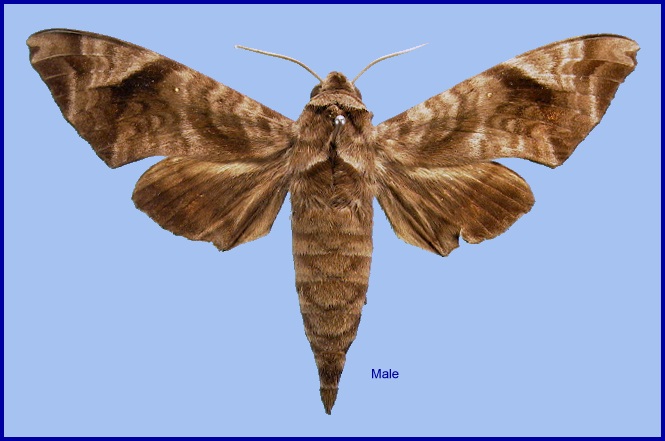
Acosmeryx castanea Rothschild & Jordan, 1903, Novit. zool. 9 (suppl.): 531. Type locality: [Japan, Honshu, Kanagawa,] Yokohama.
Synonym. Acosmeryx castanea kuangtungensis Mell, 1922.
Synonym. Acosmeryx castanea conspicua Mell, 1922.
Synonym. Acosmeryx castanea distincta Clark, 1928.
Note. With regard to Acosmeryx castanea, Zolotuhin & Yevdoshenko (2019) (STI 22079) stated 'Two subspecies are recognized: the nominate one from Japan and the continental ssp. kuangtungensis Mell, 1922, from Korea, China and Vietnam. Taiwanese (genetic) subspecies is still undescribed.' In fact, no subspecies are currently recognized in Acosmeryx castanea as kuangtungensis was synonymized with the nominotypical subspecies by Clark (1928) (STI 17252). Furthermore, although DNA barcode samples from Japan, Taiwan and mainland China do form three clusters on a neighbour-joining tree, the maximum divergence between any two samples is only 0.926% (mean distance = 0.48%) and all samples comprise a single BIN, AAC1575. Consequently, it is not considered that DNA barcodes support any formal subdivision of the species, particularly when based solely on a na´ve interpretation of divergence values. As Zolotuhin & Yevdoshenko (2019) (STI 22079) did not formally reinstate kuangtungensis, their suggestion is simply ignored in the STI and here (Ian Kitching/Sphingidae Taxonomic Inventory, pers. comm. 2020).
[Further details on this species in Japan, as well as photos of many stages, can be found on Digital Moths of Japan.]
Wingspan: 75--90mm. Wings less elongate than in Acosmeryx omissa, not dentate, or at most with vestigial teeth. Forewing upperside similar to that of Acosmeryx omissa; antemedian band more or less completely brown; oblique discal band with proximal edge more curved than in Acosmeryx omissa, extending distad between veins M2 and Cu1; first discal line almost as indistinct as in Acosmeryx omissa against the dark background, the bars between veins Cu1 and Cu2 of lines 3 and 4 not heavier than the others, nor closer together; subapical grey area sharply delimited at vein M2, as in Acosmeryx naga naga, not extending beyond this vein. Outer discal area of forewing and discal area of hindwing undersides a more reddish tawny than in Acosmeryx sericeus, and considerably more so than in Acosmeryx omissa. Forewing underside with grey costal scaling no more conspicuous than in Acosmeryx omissa; grey scaling within the distal marginal border diffuse, less distinct than in Acosmeryx omissa. Hindwing upperside less olive-grey than in either Acosmeryx omissa or Acosmeryx naga; discal area somewhat cinnamon-rufous along the distinctly marked, chestnut-olive, distal marginal band; a faint discal line present running from the costa to the hind angle. Body upperside chestnut brown, shaded with grey; dark markings of thorax and abdomen indistinct. Thorax underside olivaceous cinnamon-rufus. Abdomen underside ferruginous.
In the male genitalia, gnathos with lobes almost pointed. Harpe with process similar to that in Acosmeryx sericeus, the ventral edge dentate. Phallus more strongly and obliquely rounded than in the other species of Acosmeryx, the armature helmet-like. In the female genitalia, ostial plate transversely folded. Ostium free, subapical.
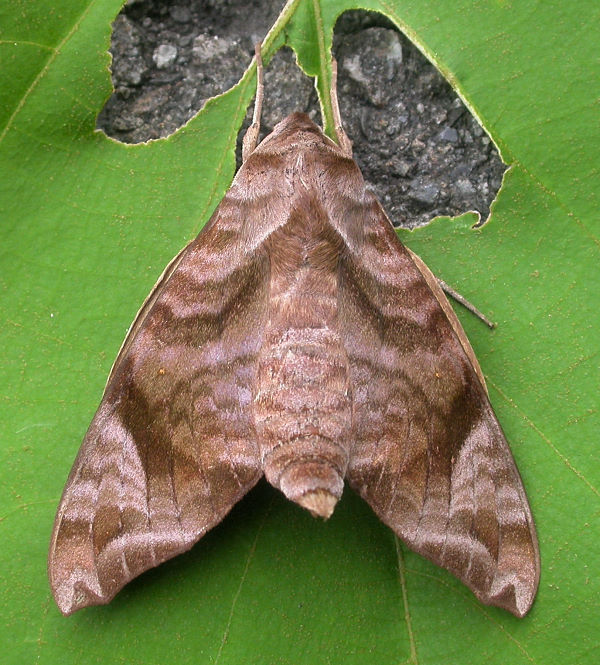
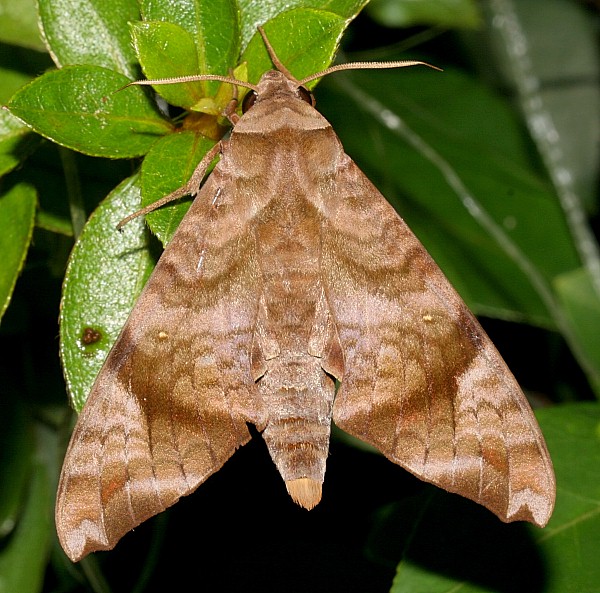
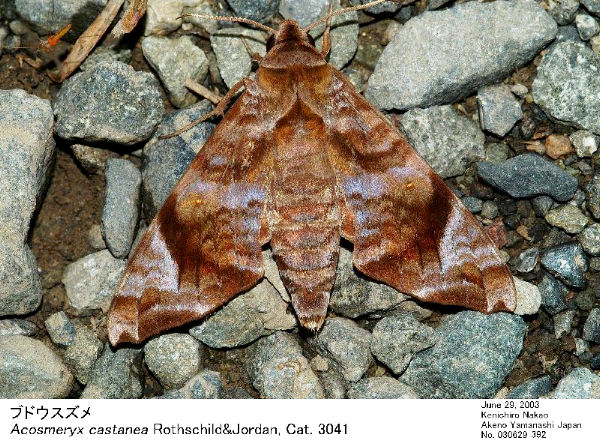
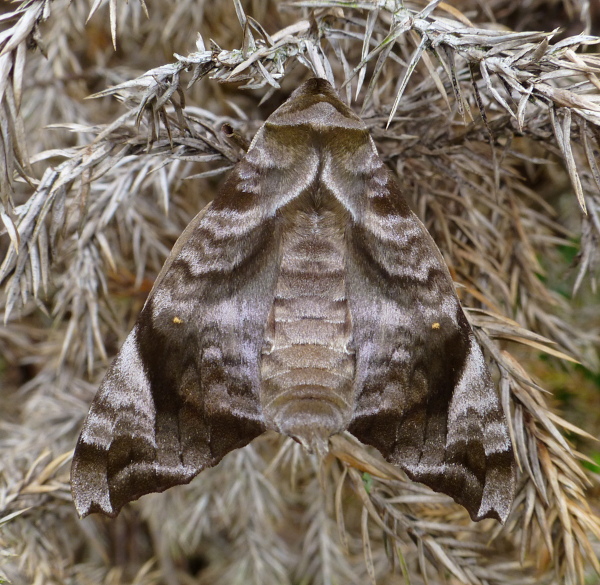
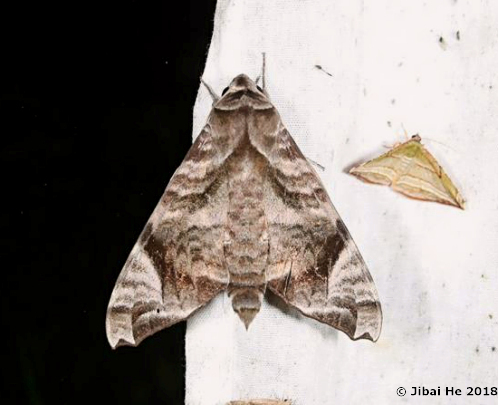
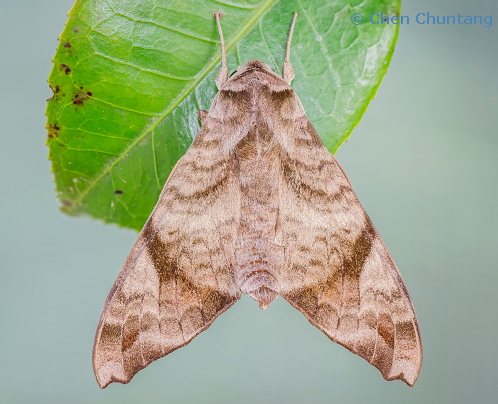
China: iii-ix (Hong Kong); 31.v (Guangdong); vi (Zhejiang; Jiangxi; Hainan; Hubei); vii (Jiangxi; Guizhou; Guangxi). Taiwan: iii-v (Kaohsiung Hsien); vi (Kaohsiung Hsien; Nantou Hsien); vii (Pingtung Hsien); ix (Hualien Hsien). Japan: 26.iv (Okinawa); 21.v (Honshu); 9.vi (Honshu); 21-24.vi (Ryukyu Archipelago); 16-29.vii (Shikoku; Honshu; Tsushima; Kyushu); viii (Honshu).
Kendrick (2002) states that it is multivoltine in Hong Kong, occurring from March until late September.
Park et al. (1999) give late June until mid August as the flight period in Korea, which is the same as for Japan.
OVUM: Oval (1.09 x 1.29).
LARVA: Full-fed 70--76mm.
![Third instar larva of Acosmeryx castanea on Causonis japonica [syn. Cayratia japonica], Jade Emperor Hill, West Lake, Hangzhou, Zhejiang, China, 11.ix.2016. Photo: © Tony Pittaway. Third instar larva of Acosmeryx castanea on Causonis japonica [syn. Cayratia japonica], Jade Emperor Hill, West Lake, Hangzhou, Zhejiang, China, 11.ix.2016. Photo: © Tony Pittaway.](a_cas_l2.jpg)
![Full-grown larva of Acosmeryx castanea on Causonis japonica [syn. Cayratia japonica], Jade Emperor Hill, West Lake, Hangzhou, Zhejiang, China, 12.ix.2016. Photo: © Tony Pittaway. Full-grown larva of Acosmeryx castanea on Causonis japonica [syn. Cayratia japonica], Jade Emperor Hill, West Lake, Hangzhou, Zhejiang, China, 12.ix.2016. Photo: © Tony Pittaway.](a_cas_l3.jpg)
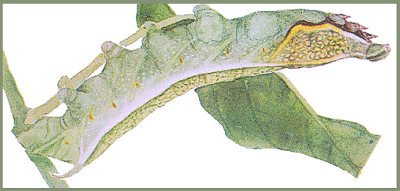
PUPA: 48--55mm. Passes the winter in a near fully-formed state, with the wing patterns of the moth clearly visible through the pupal cuticle.
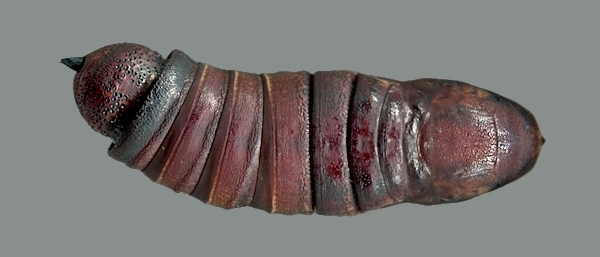
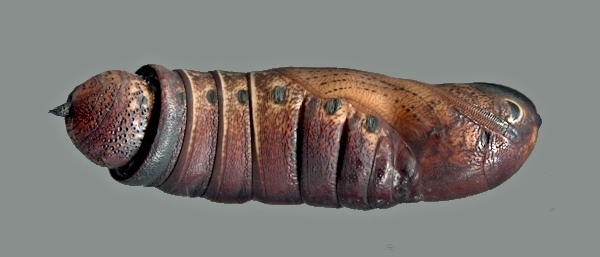
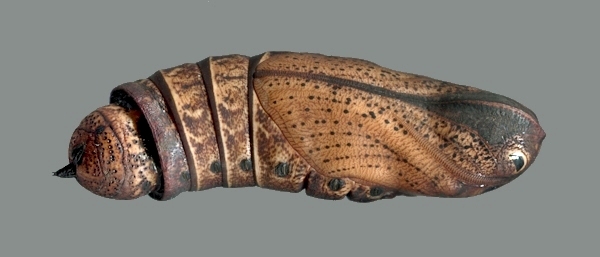
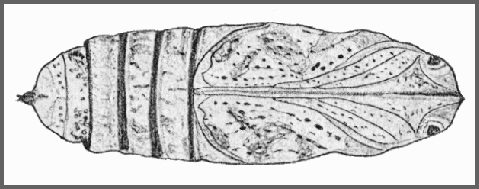
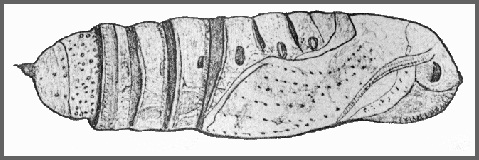
Larval hostplants. Recorded in Korea on Ampelopsis brevipedunculata and Causonis japonica [syn. Cayratia japonica], both Vitaceae (Park et al., 1999). The latter is also utilized around West Lake, Hangzhou, China (Pittaway, pers. obs. 2016). On Taiwan, on Ampelopsis brevipedunculata, Diospyros japonica, Parthenocissus tricuspidata and Saurauia tristyla.
China: Henan (Mt. Niuxinduo, Luoyang, 1730m); Anhui (Mt. Huang Shan; Xuancheng); Zhejiang (Mogan Shan; Hangzhou; Kuocang Mountain Nature Reserve); Hubei (Mt. Guifeng, Macheng); Sichuan (Kangding); Chongqing (Chongqing); Yunnan (Gaoligong Shan); south Xizang/Tibet (Mutu, Namjagbarwa region, 850m (Wang, 1988)); Guizhou (Jiucai Ling; Xinzhaidashan, Zhijin County, 1000-2000m); Hunan (Dayong); Jiangxi (Jiujiang; Tiancun, nr. Xingguo; Le'an); Fujian (Longqi Shan; Wuyi Shan); Guangdong (Wanzishan, Deqing; Nanling National Forest Park, 1100m (Morishita & Kishida, 2000)); Hong Kong (Shek Kong); Guangxi (Jiajiu Shan, Bamian; Dayao Shan; Maoer Shan, 1800m); Hainan (Duowen Ling, nr Lingao; Longhushan, Wenchang City).
Taiwan: Nantou Hsien (Puli; Feng-Huang Nature Education Area; Wulai); Kaohsiung Hsien (Shanping, 640m; Liukuei); Pingtung Hsien (Kenting); Taipei Hsien (Fushan).
South Korea: North Cholla Province (Jiri-san); South Cholla Province (Yeon-do); South Kyongsang Province (Yeohang-san); Cheju Province (Cheju-do; Topyung; Youngsil; Ora-dong; Gwaneum Temple; Seoguipo; Bijarim; Andeok; Halla-san; Hare-ri; Donnaeko).
Japan: Hokkaido; Honshu (Kugenuma; Nii-jima; Tokei-ji; Tokyo; Yokohama); Shikoku (Usa); Kyushu (Nishinakama); Tsushima (Izuhara); Ryukyu Archipelago (Okinawa (Manabe et al., 2014); Oshima Island; Tokunoshima).
Eastern and southern China, Taiwan, South Korea and Japan. Reported from Sikkim, India by Khan & Raina (2017) and Vietnam (Le & Vu, 2024).
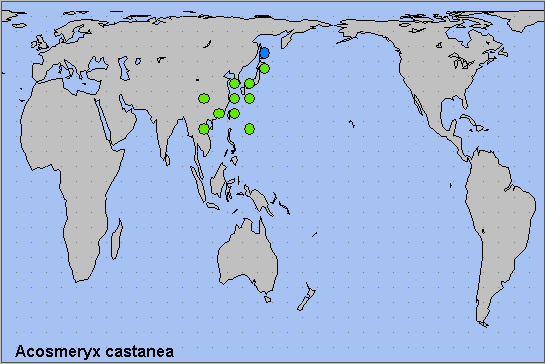
 Return to Sphingidae of the Eastern Palaearctic species list
Return to Sphingidae of the Eastern Palaearctic species list